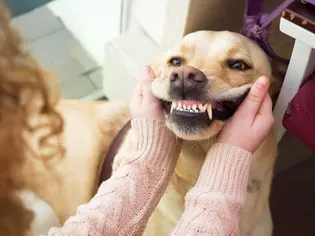How to Care for Your Dog's Teeth
Updated on 04/26/24

Unlocking the Secret to a Sparkling Canine Smile: The Ultimate Guide to Dog Dental Care
As loving dog owners, we cherish our furry companions with all our hearts. Just like we prioritize our own oral health, the well-being of our canine friends extends to their pearly whites too. Neglecting their dental hygiene can lead to a multitude of health issues, compromising their overall happiness and longevity.
In this comprehensive guide, we'll delve into the intricacies of dog dental care, empowering you with the knowledge and techniques to maintain a sparkling and healthy canine smile. From understanding the anatomy of your dog's teeth to adopting a proactive approach to dental hygiene, we'll cover every aspect to ensure your beloved pet enjoys a pain-free and healthy mouth.
Chapter 1: Understanding Your Dog's Dental Anatomy
Just like humans, dogs have different types of teeth, each serving a specific purpose. Understanding their dental anatomy is crucial for providing targeted care:
- Incisors: These sharp, front teeth are used for biting and cutting food.
- Canines: The long, pointed teeth located on both sides of the incisors help grip and tear meat.
- Premolars and Molars: These flatter, back teeth grind and crush food, essential for efficient digestion.
Chapter 2: The Importance of Dental Hygiene for Dogs
Maintaining good dental hygiene for dogs is paramount for their overall health. Neglecting their teeth can lead to a cascade of problems, including:
- Bad breath: This is one of the most common signs of poor dental hygiene, caused by the buildup of bacteria and plaque on the teeth.
- Gum disease: Plaque can harden into tartar, which irritates and inflames the gums, leading to pain and bleeding.
- Tooth decay: Plaque and tartar can erode tooth enamel, resulting in cavities and tooth loss.
- Abscesses: Advanced gum disease can lead to the formation of abscesses, which are painful infections within the jawbone.
- Systemic diseases: Bacteria from infected teeth can enter the bloodstream and spread throughout the body, potentially causing heart, liver, and kidney problems.
Chapter 3: Proactive Dental Care for Dogs
Adopting a proactive approach to dental hygiene is the cornerstone of maintaining a healthy canine smile. Here's how:
- Daily Brushing: Brushing your dog's teeth daily is the gold standard for dental care. Use a specially designed dog toothbrush and toothpaste.
- Dental Chews and Toys: Dental chews and toys can help remove plaque and tartar, providing a fun way to clean their teeth.
- Regular Veterinary Checkups: Schedule regular dental checkups with your veterinarian to assess your dog's oral health, remove any accumulated tartar, and address any underlying issues.
Chapter 4: Recognizing Dental Problems in Dogs
Observing your dog's behavior and appearance can provide clues about potential dental problems:
- Bad Breath: Persistent bad breath can indicate poor dental hygiene, gum disease, or other underlying medical conditions.
- Drooling: Excessive drooling can be a sign of pain or discomfort in the mouth.
- Difficulty Eating: If your dog is reluctant to eat or experiences difficulty chewing, it could be due to dental pain or discomfort.
- Red or Swollen Gums: Inflammation and redness of the gums can indicate gum disease or other dental infections.
- Loose or Broken Teeth: Loose or broken teeth can be caused by trauma, gum disease, or advanced tooth decay.
Chapter 5: Home Remedies for Dog Dental Problems
While home remedies cannot replace professional dental care, they can complement your dog's oral hygiene routine:
- Coconut Oil: Applying coconut oil to your dog's teeth can help reduce plaque and bacteria buildup.
- Apple Cider Vinegar: Diluted apple cider vinegar can be added to your dog's water bowl to help neutralize bacteria in the mouth.
- Baking Soda: Baking soda can be used to create a homemade toothpaste for dogs, helping to remove surface stains and freshen breath.
Chapter 6: Conclusion
Maintaining good dental hygiene for dogs is essential for their overall health and well-being. By following the tips and advice outlined in this guide, you can equip yourself with the knowledge and tools to keep your furry friend's smile bright and healthy for years to come. Remember, prevention is key, and a proactive approach to dental care will ensure a pain-free and healthy life for your beloved canine companion.
Explore More Pets

Basic Training
Puppy and Baby Introductions

Working Dog Breeds
All About Search and Rescue Dogs

Dog Treatments
Puppy Vaginitis: Signs, Causes and Treatment

Dog Adoption
After More Than 1,200 Days in the Shelter, Coco Goes Home

Basic Training
How to Train Your Puppy to Go on Potty Pads

Hybrid Dog Breeds
The Difference Between a Mutt, Mixed Breed, or Designer Dog?

Dog Treatments
Nail Problems in Dogs

Puppies
7 Reasons Why Two Dogs Are Better Than One